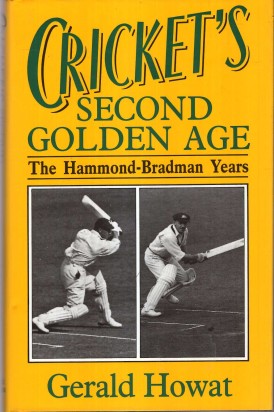Cricket’s Second Golden Age
David Taylor |Published: 1989
Pages: 300
Author: Howat, Gerald
Publisher: Hodder and Stoughton
Rating: 3 stars

The Scottish writer and teacher Gerald Howat, who died in 2007, was the author of 20 books, including a number on cricket – he is recalled for his acclaimed biography of Learie Constantine (and also taught in his subject’s native Trinidad) as well as titles on Walter Hammond, Plum Warner and Len Hutton. Here he revisits the career of Hammond, and his great nemesis Donald Bradman, subtitling this book ‘the Hammond-Bradman Years.’ He takes as his starting point Hammond’s debut in August 1920, and ends with the Don’s farewell in March 1949.
The book is laid out in logical fashion, There is a chapter on county cricket in the 1920s, and another in the 1930s. There are two corresponding chapters on the Ashes contests of both decades. Each of the other Test nations of the time gets its own chapter which deals with their domestic cricket as well as their efforts in Test cricket – formative years in the case of India, New Zealand and the West Indies. He is pessimistic, writing in 1989, on the prospects of a return for South Africa, in a piece entitled ‘Cricket for the Few.’ Interestingly he notes “I have to record that one distinguished South African Test player of the 1930s and 1940s told me in unequivocal terms that he supported apartheid.”
Finally, Howat makes his case for the period 1920-48 being considered ‘cricket’s second golden age.’ There is much in his favour, Huge crowds attended three-day championship matches (at reasonable prices), players were in many cases approachable – often travelling by public transport – and aware of their responsibility to entertain, and international cricket was rare enough to be special. Only Australia and South Africa played five Tests in a series in England and without constant exposure on TV players from overseas had a particular aura. “Every cricketing country was touched by the excitement of players arriving from another land perhaps with distinct cultural differences or bringing to the descendants of emigrants a whiff of the land of their forebears.”
There is plenty about Bodyline of course, but Howat points out that (even in 1989) a number of books had appeared on that series, and the dozen or so pages he devotes here are quite sufficient. Interestingly, at the end of such an acrimonious series, the state premier of New South Wales declared at a dinner given for the tourists that ‘our visitors played cricket in the best tradition of the British people’ – a view somewhat at odds with most of his countrymen. And there are a few good anecdotes – Neville Cardus once met Wilfred Rhodes and Emmott Robinson on a Sunday in London, remarking on the fine weather after the rain, and they grumbled that there was ‘a sticky wicket wasting at Lord’s.’ The illustrations include a number of contemporary cartoons as well as one photograph of the ill-fated airship R101 over Lord’s during the 1930 Ashes Test.
To deal with almost thirty years of cricket, around the world, in a book of this size meant that many seasons and series had to be given light treatment, but nothing of importance has been omitted here, and as a brief guide to the interwar and immediate postwar years, this does its job.






Cricket has witnessed historic moments. Including the great players of all the time like Sir Donald Bradman Australian Captain, Graham Gooch England, Sir Viv Richards West Indies and so on….. All have contributed to making this game watchable over the time period.
Comment by DJ Malik | 6:18am BST 15 April 2019